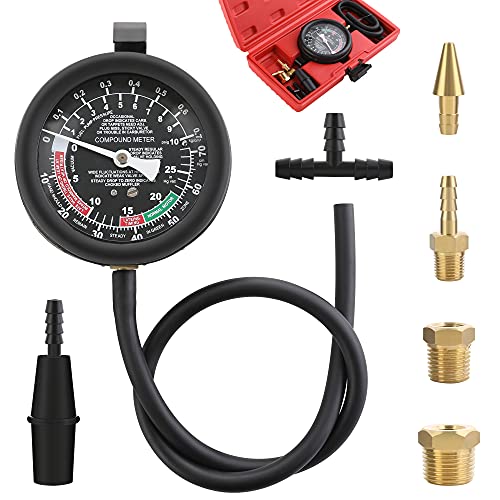Ever wondered how scientists create a near-empty space? It’s not magic! They use special tools, and a vacuum gauge is one of the most important. Imagine trying to measure something you can’t see or touch. That’s what a vacuum gauge does – it measures the emptiness of a space.
Choosing the right vacuum gauge can be tricky. Different gauges work in different ways. Understanding these differences is key. Picking the wrong gauge can lead to wrong readings. This can mess up your experiments and waste time and money. It can be a real headache.
This blog post will help you. You’ll learn about different types of vacuum gauges and how they work. You’ll discover which gauge is best for your needs. We’ll also explore important things to think about when you choose a gauge. By the end, you’ll be able to pick the perfect vacuum gauge for any job. Now, let’s dive in and explore the world of vacuum gauges!
Our Top 5 Vacuum Gauge Recommendations at a Glance
Top 5 Vacuum Gauge Detailed Reviews
1. Hromee Fuel Pump and Vacuum Tester Gauge
Rating: 9.4/10
The Hromee Fuel Pump and Vacuum Tester Gauge is a handy tool kit. It helps you find problems in your car’s engine. You can use it to check the fuel pump, vacuum lines, and other parts. This tool is great for anyone who wants to keep their car running smoothly. It is mainly for carburetor engines with a mechanical fuel pump.
What We Like:
- It tests fuel pump pressure.
- It checks vacuum lines.
- The gauge is easy to read with a large scale.
- It comes with many adapters for different vehicles.
- The kit includes a carrying case for easy storage.
What Could Be Improved:
- It is only for carburetor engines.
- The instructions could be clearer.
This Hromee kit is a good tool for car maintenance. It helps you find and fix problems with your car’s engine. The kit is useful for both beginners and experienced mechanics.
2. SENCTRL 30 inHg Vacuum Silicone Oil Liquid Filled Low Pressure Gauge
Rating: 8.9/10
The SENCTRL Vacuum Gauge is a handy tool for measuring low pressure. It’s designed for air conditioning, HVAC systems, and vacuum tests. This gauge has a 2.5″ dial and is filled with silicone oil. This helps it work well in different temperatures and prevents damage. It’s built with stainless steel and brass, so it’s tough and lasts a long time. It can measure air, oil, and other non-corrosive gases and liquids. It also has a waterproof design.
What We Like:
- The gauge uses brass and stainless steel. These parts measure pressure of water, oil, and air.
- It works well with air conditioning lines, tanks, and HVAC tools.
- A stainless steel case keeps the dial safe.
- The silicone oil stops the needle from shaking. It also protects the inside from bumps.
- It works in temperatures from -40 to 140℉.
- The gauge shows pressure in two ways: inHg and kPa.
- It is waterproof, so you can see the numbers clearly.
- It connects easily with a 1/4″ NPT thread.
What Could Be Improved:
- Some users may find the dual scale confusing at first.
- The gauge could have more detailed instructions.
In conclusion, the SENCTRL Vacuum Gauge is a reliable tool for measuring low pressure. It’s great for many different jobs and is built to last.
3. CPS VG200 Digital Vacuum Gauge
Rating: 8.7/10
The CPS VG200 Digital Vacuum Gauge is a tool for HVAC/R systems. This gauge helps test for vacuums. It has a 5-digit LCD screen. The gauge is accurate and easy to read. It is built to handle high pressure. This helps technicians with their vacuum testing tasks.
What We Like:
- ACCURATE – The gauge is calibrated to NIST standards. This means it is very accurate and reliable.
- SMART DESIGN – It has a smart sensor. This helps with temperature changes.
- SIMPLE TO CLEAN – You can clean the sensor easily. It can handle a lot of pressure.
- EASY TO READ – The digital display is big and easy to see. You can read it easily.
- USER SELECTABLE UNITS – You can pick your units of measurement. Choose from microns, torr, in/hg, or mBar.
What Could Be Improved:
- No cons were found.
The CPS VG200 is a good vacuum gauge. It is accurate and easy to use. You can trust this gauge for your HVAC/R work.
4. Punmew Vacuum Gauge Automotive Fuel Pump and Vacuum Tester Gauge
Rating: 8.8/10
The Punmew Vacuum Gauge Automotive Fuel Pump and Vacuum Tester Gauge helps you figure out what’s wrong with your car. This tool helps you test your fuel pump and vacuum system. It is a great tool for anyone who works on cars.
What We Like:
- Versatile Testing: You can use this tool for many tests. It checks fuel pump pressure and vacuum levels.
- Wide Application: This tool works on many cars with mechanical fuel pumps. It’s great for carburetor engines.
- Comprehensive Kit: The kit has everything you need. It includes a big gauge, a hose, and adapters.
- Precise Readings: The gauge gives you accurate readings. You can use it to check your engine.
- Convenient Packaging: The kit comes in a case. It’s easy to store and carry.
What Could Be Improved:
- Instruction clarity: The instructions could be more clear for some users.
- Fuel pump compatibility: It only works with mechanical fuel pumps under 14 PSI.
This Punmew Vacuum Gauge Automotive Fuel Pump and Vacuum Tester Gauge is a useful tool for car owners. It’s a good choice for anyone who wants to diagnose and fix car issues.
5. OTC 5613 Vacuum/Pressure Gauge Kit
Rating: 9.4/10
The OTC 5613 Vacuum/Pressure Gauge Kit is a handy tool for any mechanic or car enthusiast. It helps you find problems in your car’s engine. This kit helps you test vacuum lines and many engine parts. It can also test low-pressure fuel systems. The kit helps you find problems like bad rings or leaking head gaskets. You can also find cracked lines. The kit has many adapters. These adapters fit most applications. A strong case protects the kit and keeps it safe.
What We Like:
- It is great for testing vacuum lines and parts.
- You can test low-pressure fuel systems with it.
- It helps diagnose engine problems quickly.
- It helps find hard-to-find problems.
- The kit has adapters for many uses.
- The case keeps the kit safe.
What Could Be Improved:
- The instructions could be clearer for some users.
The OTC 5613 Vacuum/Pressure Gauge Kit is a valuable tool. It is a good choice for anyone who works on cars.
Vacuum Gauge: Your Guide to Choosing the Right One
Choosing the right vacuum gauge can seem tricky. This guide will help you understand what to look for. You will learn how to pick the best one for your needs.
Key Features to Look For
You need to know what the vacuum gauge will measure. Here are the important things to consider:
- Measurement Range: Vacuum gauges measure how much air is not in a space. They show pressure. Make sure the gauge can measure the range you need. Some gauges measure low vacuums. Others measure very high vacuums.
- Accuracy: How precise does the measurement need to be? A more accurate gauge will cost more. Consider what accuracy is important for your job.
- Display: How will you read the pressure? Some gauges have analog dials. Others have digital displays. Digital displays are easy to read.
- Connection Type: How will you connect the gauge to your system? Make sure the connection type matches your equipment. Common types include threaded fittings and flanges.
- Power: Does the gauge need electricity? Some gauges are battery-powered. Others need to plug into a wall outlet.
- Size and Portability: Do you need a small, portable gauge? Or is a larger, stationary gauge better? Think about where you will use the gauge.
Important Materials
The materials used in a vacuum gauge affect its durability and performance. Here are some key materials:
- Body Material: The body is often made of stainless steel or brass. Stainless steel is strong and resists rust. Brass is also strong but can corrode over time.
- Sensor Material: The sensor measures the pressure. Different gauges use different sensors. They can be made of metal or ceramic.
- Seals: Seals prevent leaks. They are usually made of rubber or other materials. Make sure the seals can handle the vacuum and the temperature.
- Glass: Some gauges have a glass face to protect the dial. Make sure the glass is tough and won’t break easily.
Factors That Improve or Reduce Quality
Quality matters. It affects how well the gauge works and how long it lasts. Here are some factors to consider:
- Calibration: A calibrated gauge is more accurate. Look for gauges that can be calibrated.
- Build Quality: A well-built gauge will last longer. Check the materials and how they are put together.
- Brand Reputation: Some brands are known for making high-quality gauges. Research brands before you buy.
- Temperature Range: Consider the temperature range the gauge can handle. Extreme temperatures can damage the gauge.
- Protection: Look for gauges that are protected from dust and moisture.
User Experience and Use Cases
Think about how you will use the vacuum gauge. Here are some common uses:
- HVAC Systems: Vacuum gauges are used to check for leaks in air conditioning systems.
- Industrial Processes: They are used in factories to monitor vacuum levels in various processes.
- Laboratories: Scientists use vacuum gauges for research and experiments.
- Automotive Repair: They are used to test car engines.
- Food Processing: Vacuum gauges help in food packaging.
- Ease of Use: Choose a gauge that is easy to read and use. Consider the display, buttons, and controls.
Vacuum Gauge FAQs
Q: What is a vacuum gauge?
A: A vacuum gauge measures the pressure in a space where most of the air has been removed. It tells you how strong the vacuum is.
Q: What units do vacuum gauges use?
A: Vacuum gauges use different units to measure pressure. Common units are Pascals (Pa), Torr, and inches of mercury (inHg).
Q: How do I choose the right measurement range?
A: You should choose a gauge that can measure the lowest and highest pressures you expect to see.
Q: What is the difference between an analog and a digital gauge?
A: Analog gauges have a needle and a dial. Digital gauges have a screen that shows the pressure numerically. Digital gauges are typically easier to read.
Q: What is calibration?
A: Calibration makes sure the gauge gives accurate readings. You can calibrate some gauges to make sure they are correct.
Q: How do I connect a vacuum gauge?
A: The connection type depends on your equipment. Common types include threaded fittings and flanges. You must connect the gauge properly to avoid leaks.
Q: Why is accuracy important?
A: Accuracy is important to get the correct measurements. It is very important for critical applications.
Q: What materials are best for a vacuum gauge?
A: Stainless steel is a good choice for the body. It is strong and resists rust. Durable seals are also important.
Q: How do I maintain a vacuum gauge?
A: Keep the gauge clean. Protect it from extreme temperatures. Calibrate the gauge regularly.
Q: Where can I buy a vacuum gauge?
A: You can buy vacuum gauges online or at industrial supply stores.
In conclusion, every product has unique features and benefits. We hope this review helps you decide if it meets your needs. An informed choice ensures the best experience.
If you have any questions or feedback, please share them in the comments. Your input helps everyone. Thank you for reading.

Hi, I’m Tom Scalisi, and welcome to The Saw Blog! I started this blog to share my hands-on experience and insights about woodworking tools—especially saws and saw blades. Over the years, I’ve had the chance to work with a wide range of tools, and I’m here to help both professionals and hobbyists make informed decisions when it comes to selecting and using their equipment. Whether you’re looking for in-depth reviews, tips, or just advice on how to get the best performance out of your tools, you’ll find it here. I’m excited to be part of your woodworking journey!





